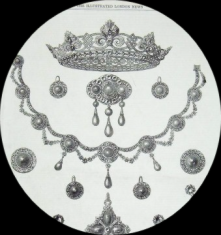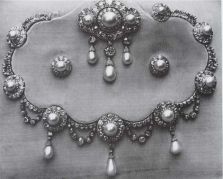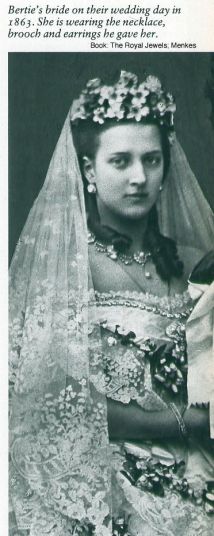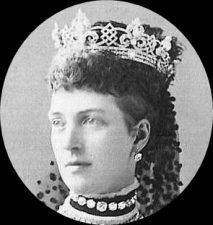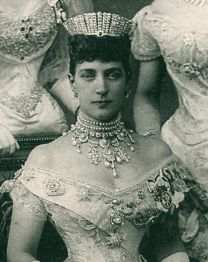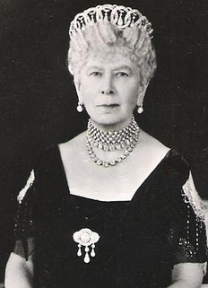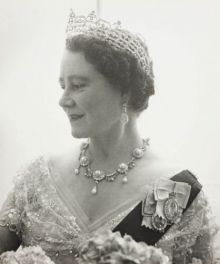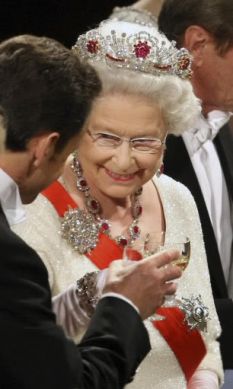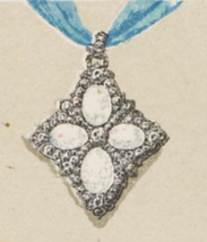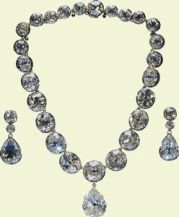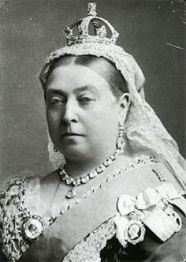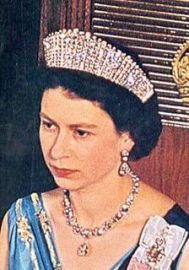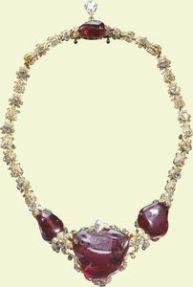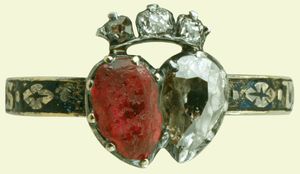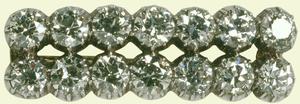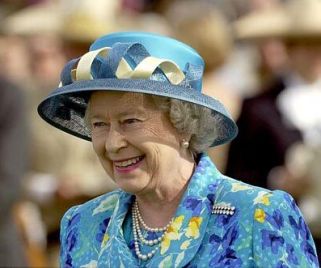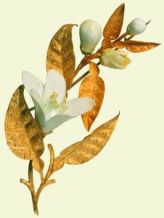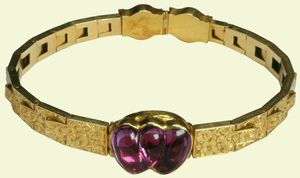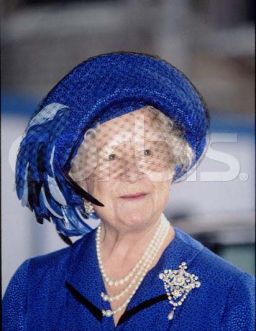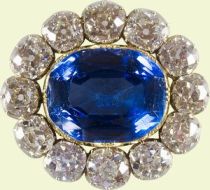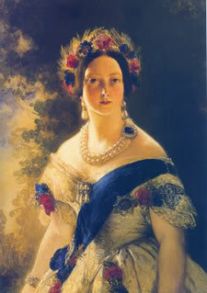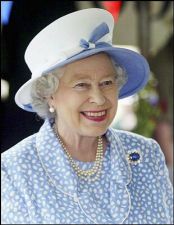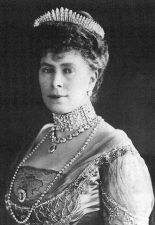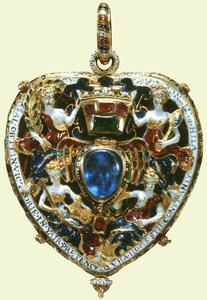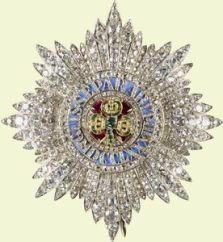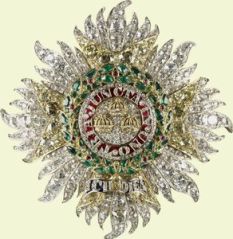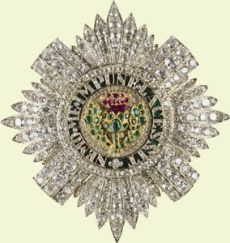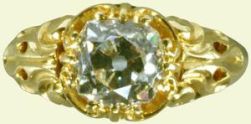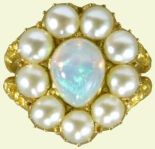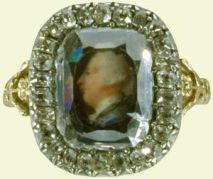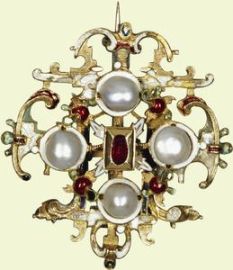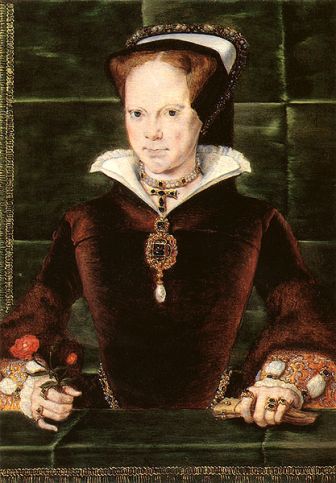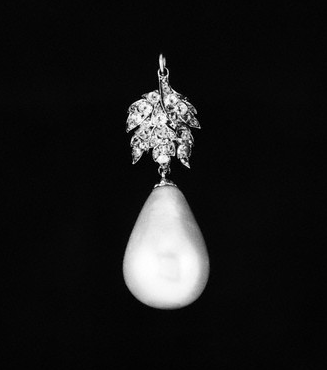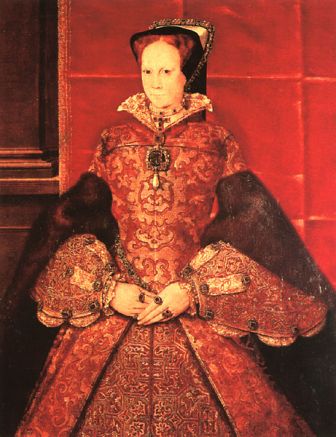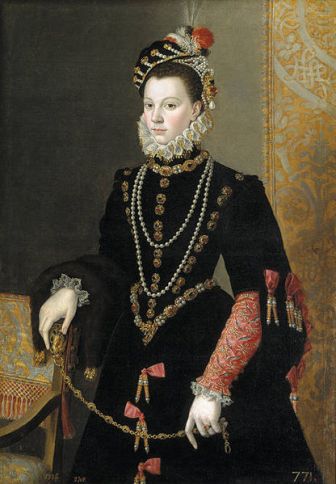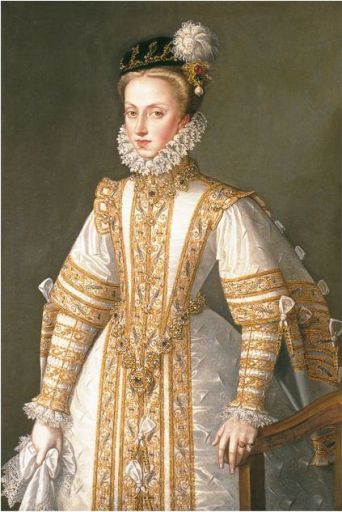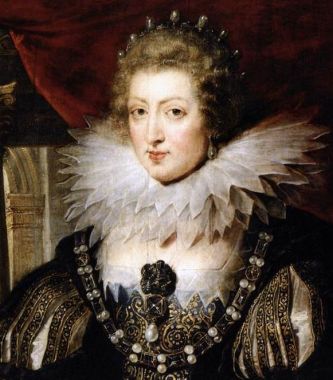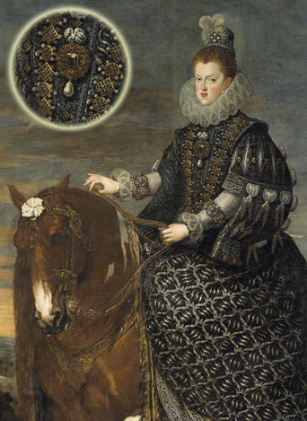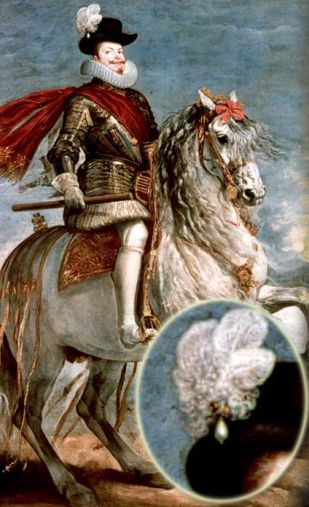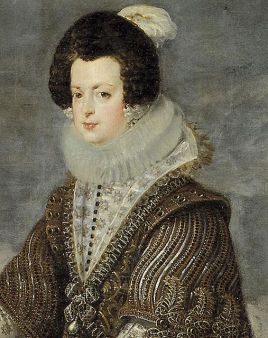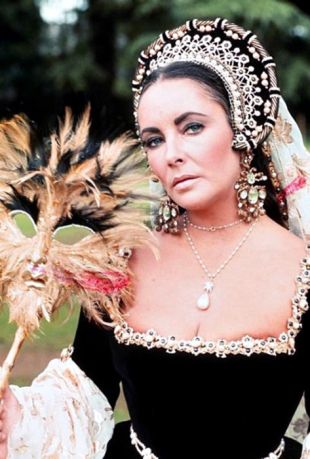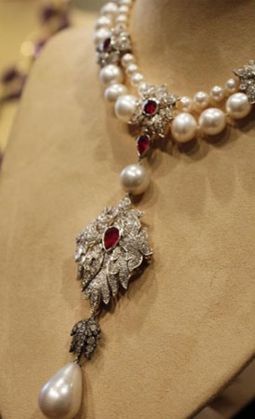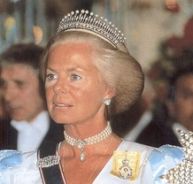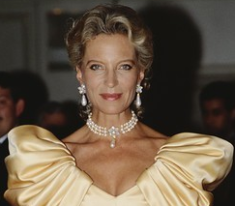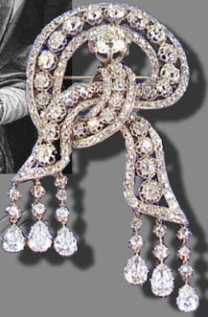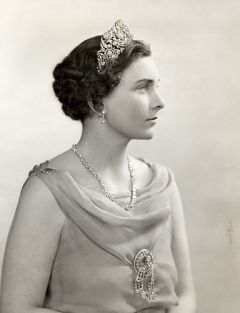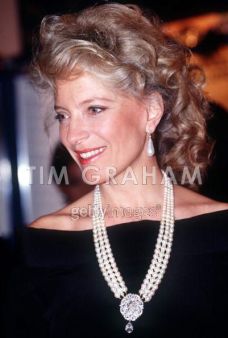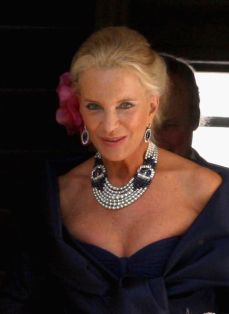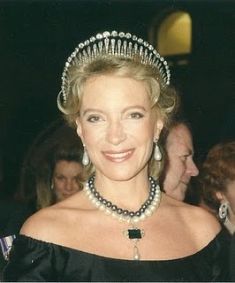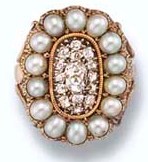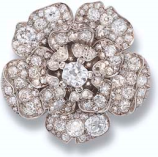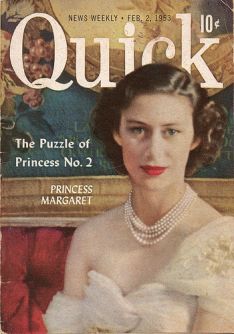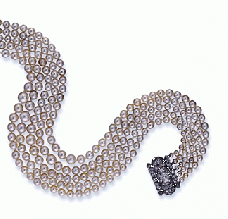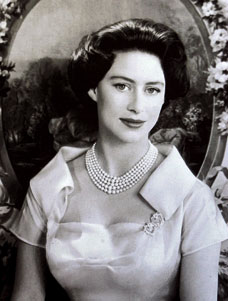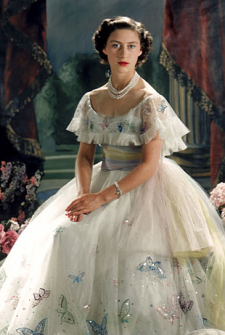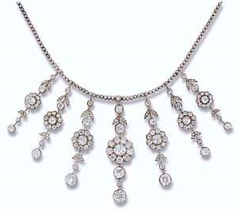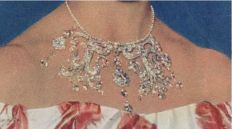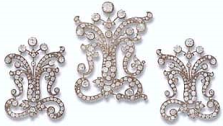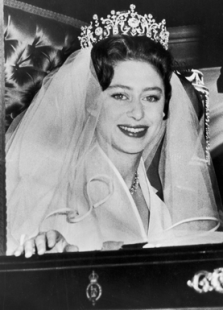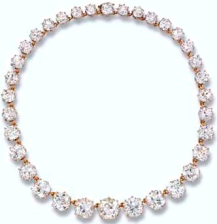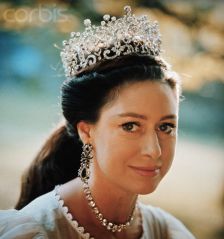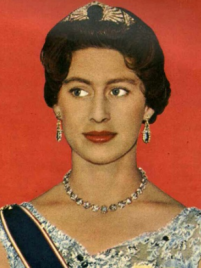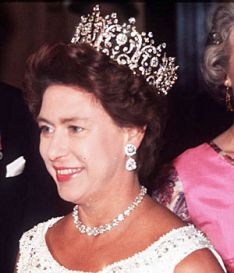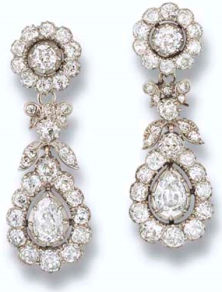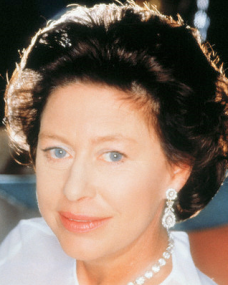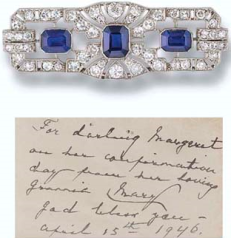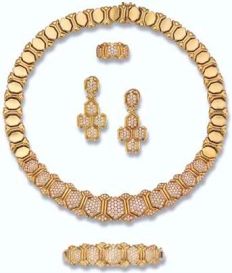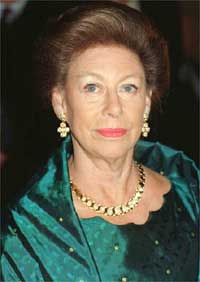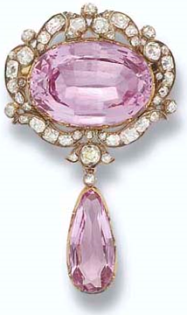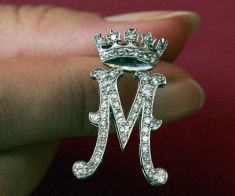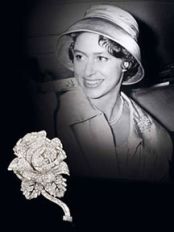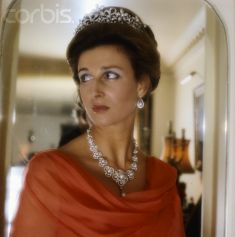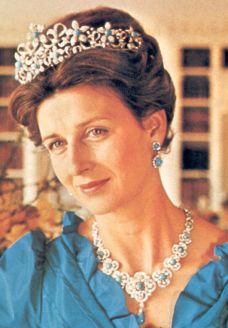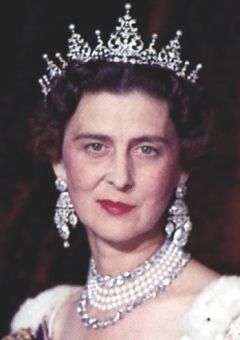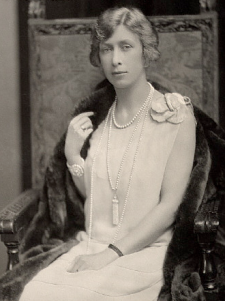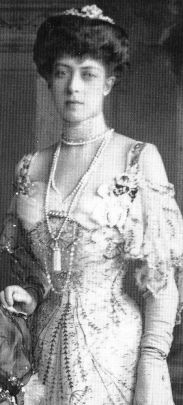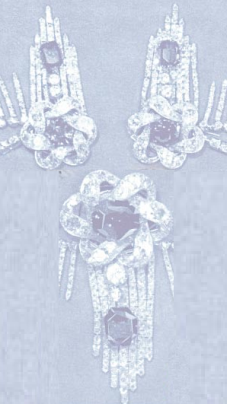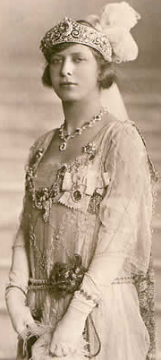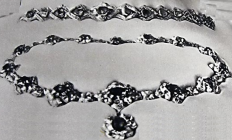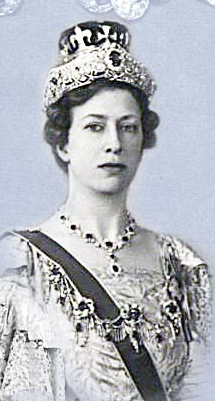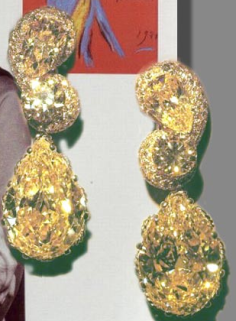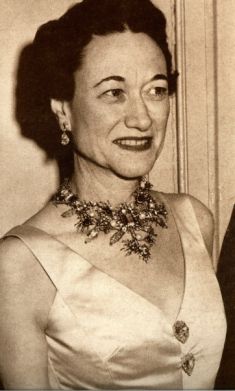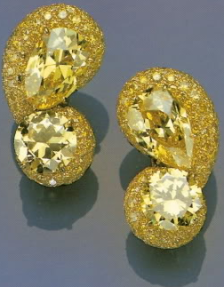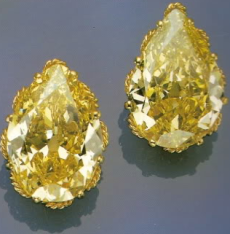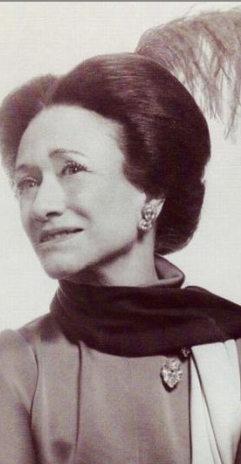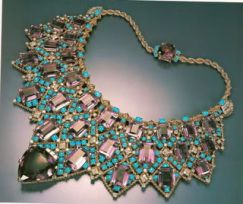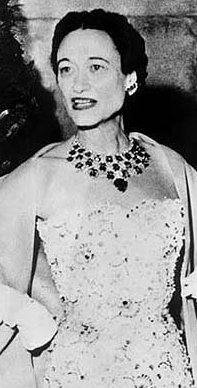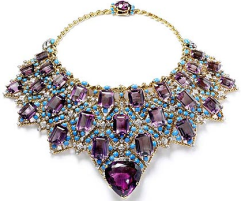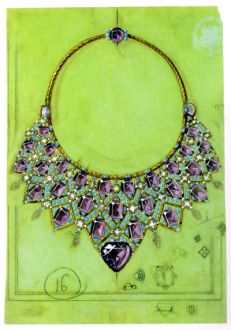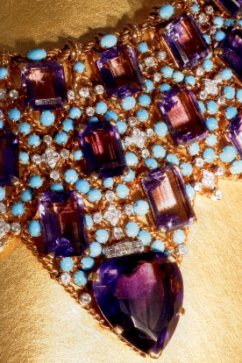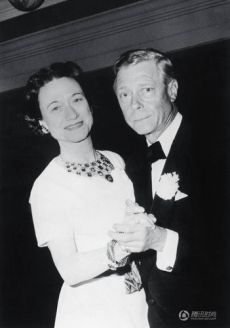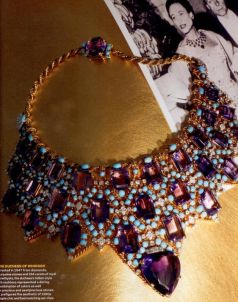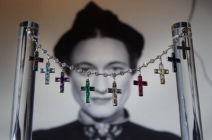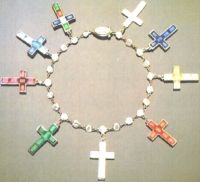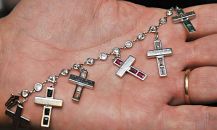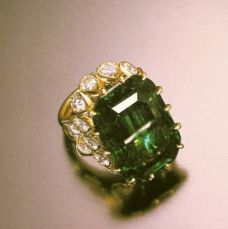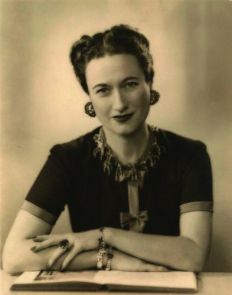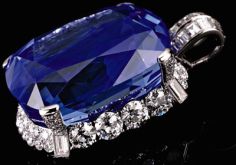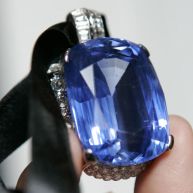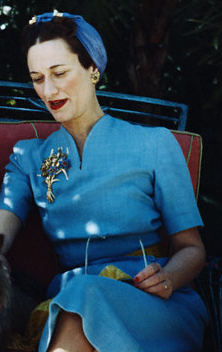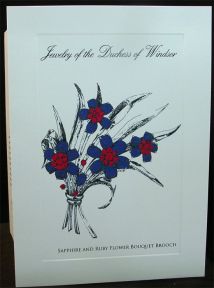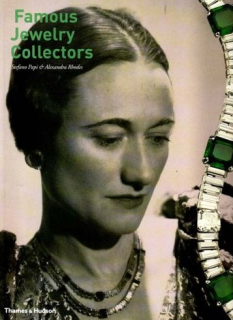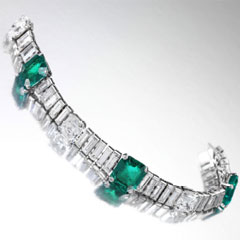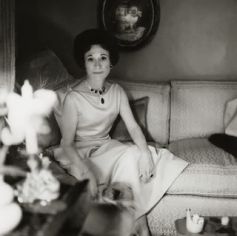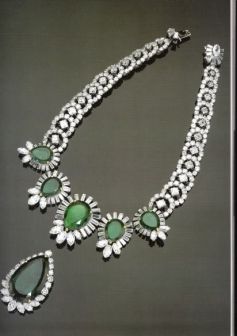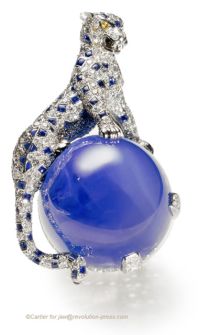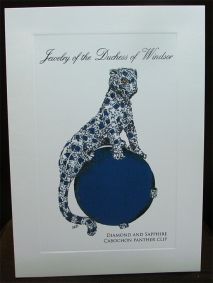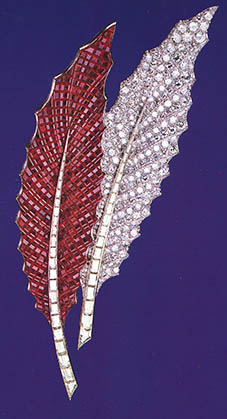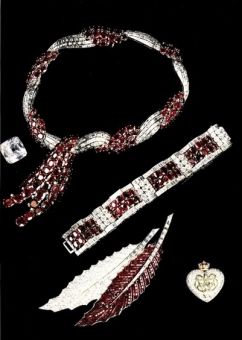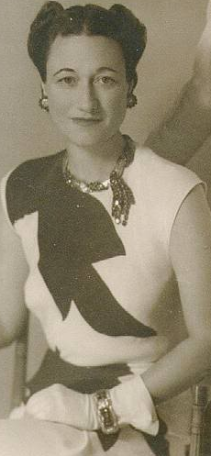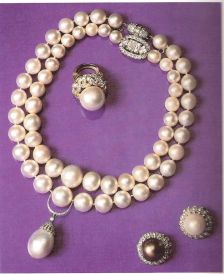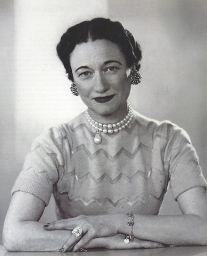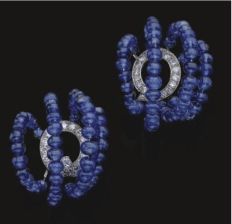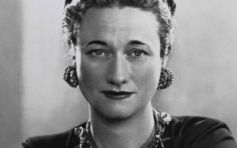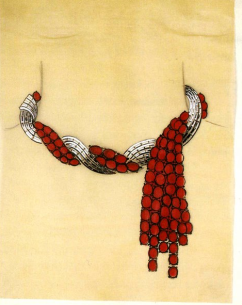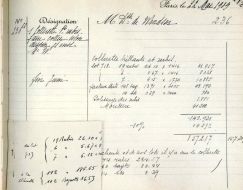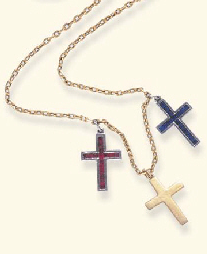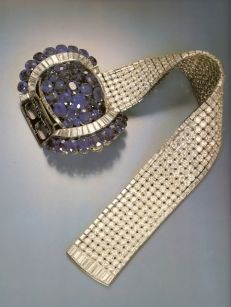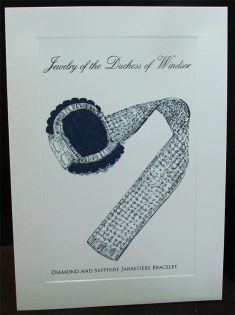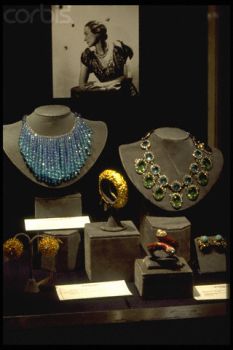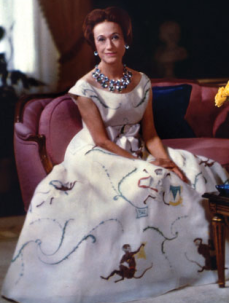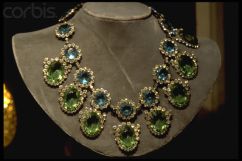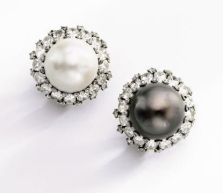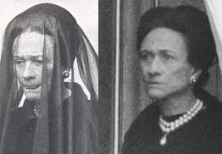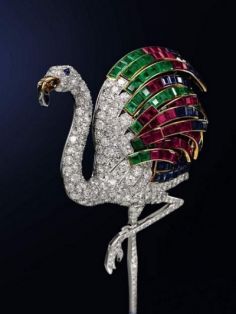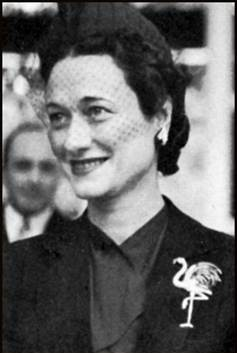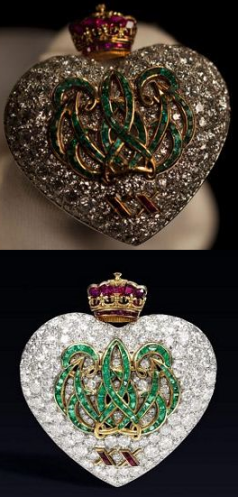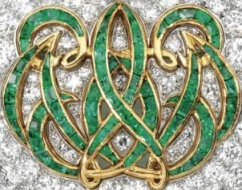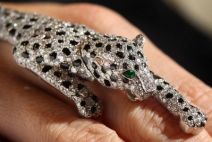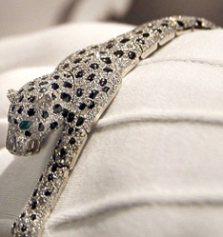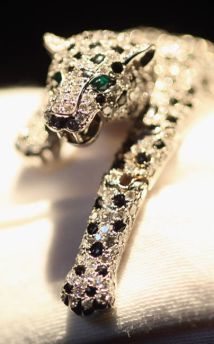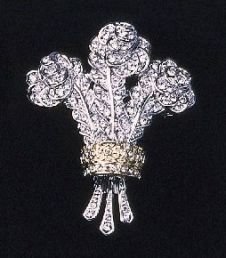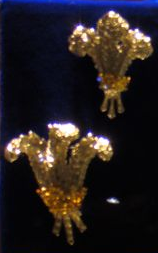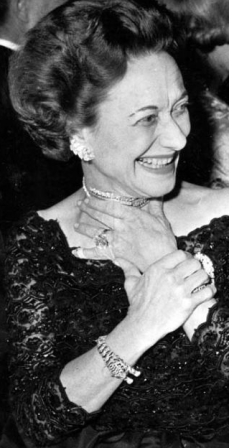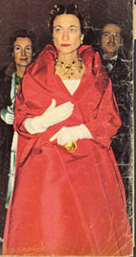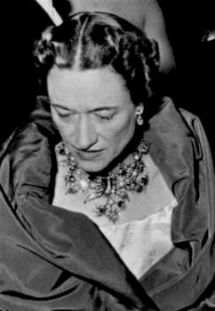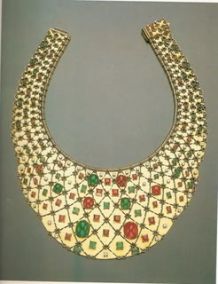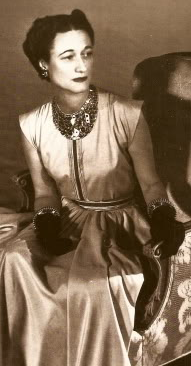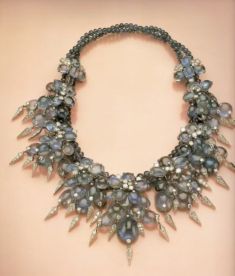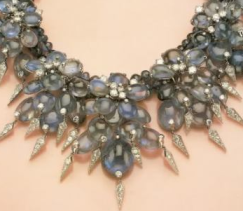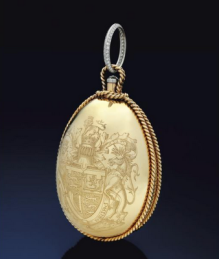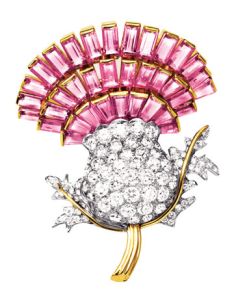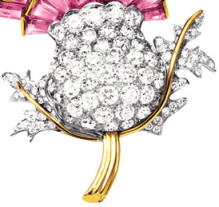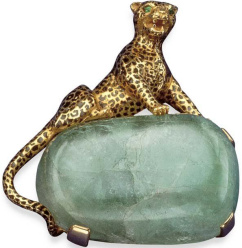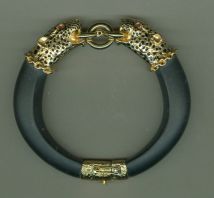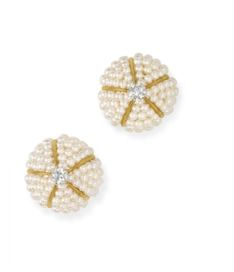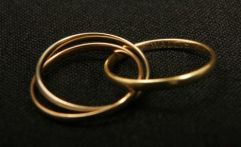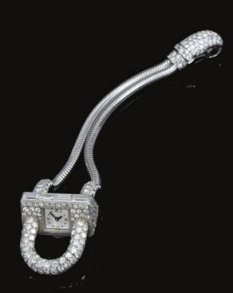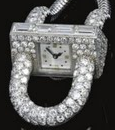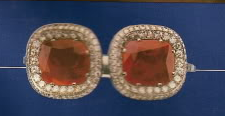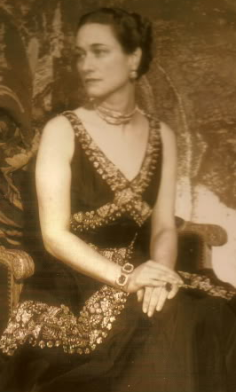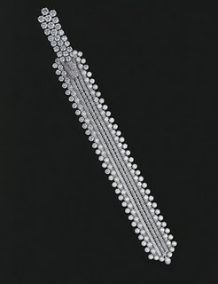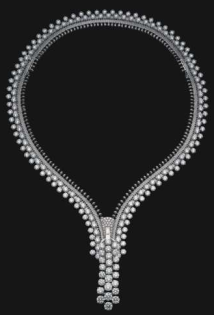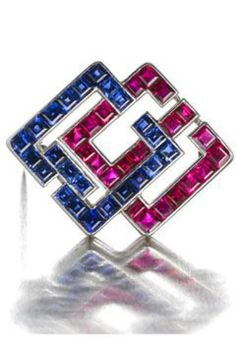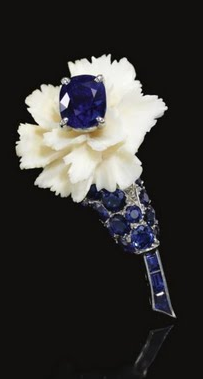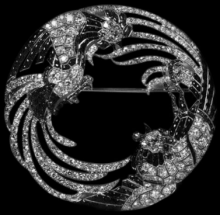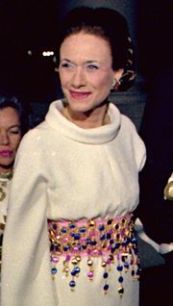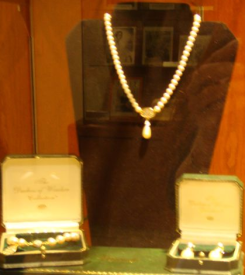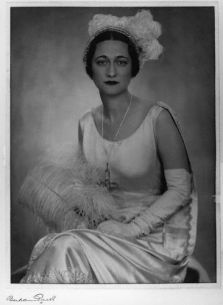Jewellery of Today's British Royalty - Page 2
Jump to navigation
Jump to search
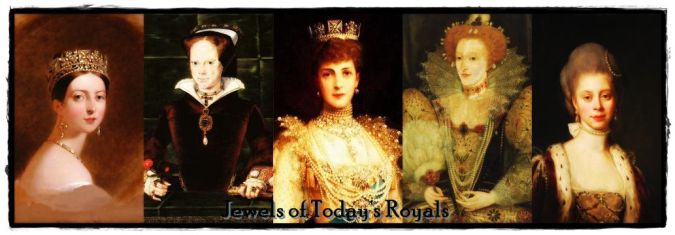 BACK TO PAGE 1 OF THE BRITISH ROYAL JEWELS COMPILED AND RESEARCHED BY MEG MCGATH PLEASE DO NOT REPLICATE WITHOUT PERMISSION |
| Queen Alexandra, Queen Consort of King Edward VII |
DAGMAR NECKLACE OF QUEEN ALEXANDRA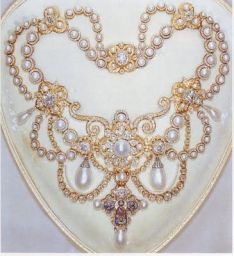 The necklace was made in 1863 when the highest fashion was historicism. Made by the Danish court jeweller at the time, Julius Didrichsen, it is made in a neo-Byzantine style. The style matches the replica of the Dagmar cross which was a Byzantine cross found in the sarocophagus of the mediaeval Danish Queen Dagmar, the wife of King Waldemar the Victorious. 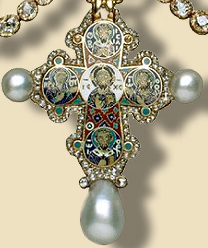 The was the wedding gift to Princess Alexandra from King Frederik VII. It may well be the most splendid Danish wedding present ever given to a Danish Princess and reportedly cost £7,000 at the time of its manufacture. King Frederik had a deep personal interest in antiquarian studies and the idea that the wedding gift should include the “very Danish” historic cross was his. 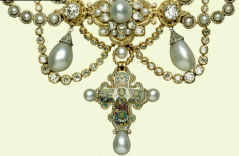 Shortly after her wedding, the Princess took the necklace to Garrards to have the centre clusters made convertible into brooches, which involved some resetting. As Princess of Wales, she wore the multi-coloured enamelled cross on a string of pearls. Above she is pictured at her coronation in 1902 wearing the Danish necklace on her bodice under the swags of pearls. 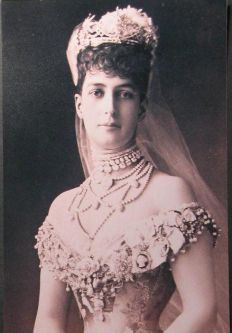 The necklace held a sentimental value with the Danish Royal family. Her sister was named Princess Dagmar (later renamed Empress Marie Feodorovna). The necklace held a sentimental value with the Danish Royal family. Her sister was named Princess Dagmar (later renamed Empress Marie Feodorovna). 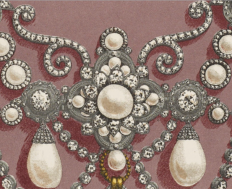 Dagmar would later become the second to last Czarina of the Romanov Dynasty of Russia by marrying Tsar Alexander III. They were parents to the last Czar, Nicholas II. 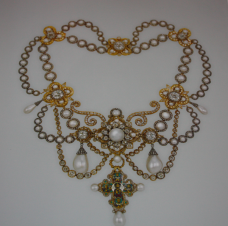 The connection between the sisters made their children cousins. George V and Nicholas II were almost the spitting image of each other. 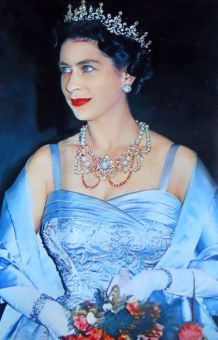 When Queen Elizabeth II and the Duke of Edinburgh paid a state visit to Denmark in 1957, the Queen wore the necklace at the gala performance in The Royal Theatre. She detached the cross and the pear-shaped pearls. 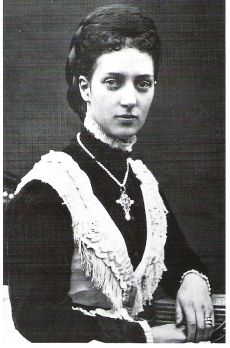 The cross is detachable and Alex wore the cross from the necklace without all the pearls. | 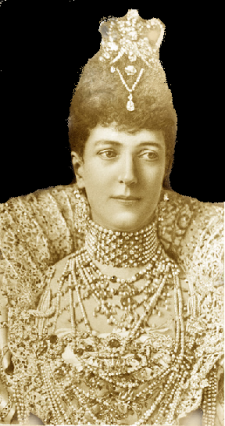 INDIAN DIAMOND & EMERALD NECKLACES 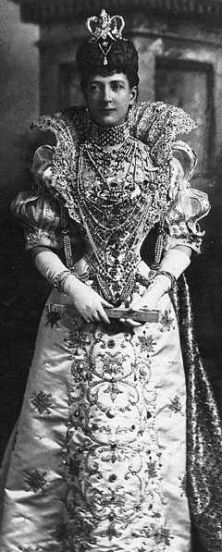 In 1863, Alexandra received this suite of Indian ornaments from her mother-in-law, Queen Victoria, as a wedding present. It comprising of a collar, an armlet, and two bracelets. 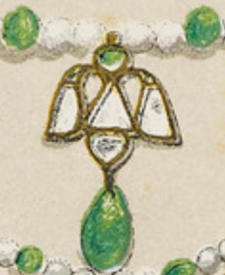 In the above photos, Alexandra wore the suite as part of her costume as Marguerite of Valois to the Devonshire Ball in 1897. 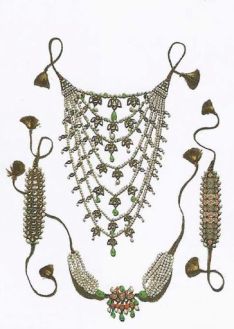 The suite was made from uncut emeralds, diamonds and pearls. The seven-row collar of pearl and emerald beads was hung with a multitude of pearl drops and diamond pendants, which were enamelled on the back. 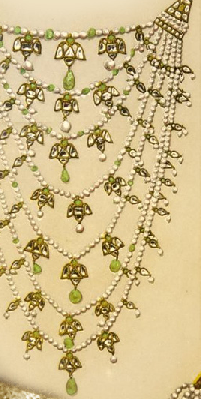 According to the ROYAL MAGAZINE, "Queen Mary broke up this piece and made a rope of pearl and emerald beads, which she wore, before giving them to Alice, the future Duchess of Gloucester and her daughter-in-law, as a wedding gift in 1935." I'm not sure I agree with this assessment as the jewels look completely different and are thicker. 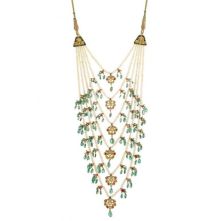 [similar necklace, maybe that of Princess Mary] When Alexandra's granddaughter, Princess Mary, was married in 1922, the Queen gave Mary a similar gift to the one she received as a wedding present in 1863. The gift was a six row emerald bead and pearl necklace composed of 63 graduated pearls and 64 graduated emerald beads strung alternately with green and white enamelled barrel snap. [Source: <a href="https://www.royal-magazin.de/england/mary-lascelles-harewood/princess-royal-pearl-collier.htm" target="_self">ROYAL MAGAZINE</a>] |
|
| Necklace and Earrings presented by The Corporation of the City of London 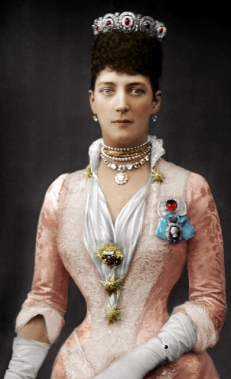 The necklace ". . . consists of 32 Golconda diamonds (old English cut), the centre stone, from which the rest graduate, weighing 13 carats 3 1-32 grains. The beauty of this collection of stones was represented to lie in the uniformity and harmony of size, shape and brilliancy. The earrings are equal in quality to the necklace, and consist of very large brilliant tops and drops with diamonds between, the top stones weighing 12½ carats, and the drops, which are said to be matchless, 17¼ carats, the whole weight of necklace and earrings being 171 ½ ¼ 1/16 carats.” The centre stone of the necklace was valued at £5,000, while the total value of the gift was £10,000. Both items were made by Garrard and Co. The diamond rivière and earrings with pear-shaped diamond pendants were the gift of the Corporation of the City of London and the Princess wore the necklace on the day of her wedding. The future Queen Alexandra often wore the necklace and the earrings, without the diamond drops. The Princess of Wales added the diamond drops to her diamond collet necklaces as pendants and sometimes even to the diamond and pearl necklace that she received as the wedding gift of the Prince of Wales. The necklace was passed on to the crown. | Queen Alexandra's Diamond Stars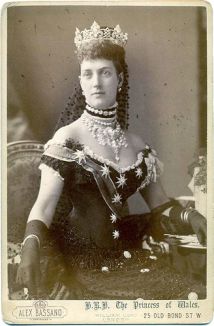 In September 1864, Garrards repaired and altered five stars for the Prince of Wales “and in November spare diamonds from a tiara (presumably dismantled) were mounted in ‘3 Star hair pins’ for £125, while in 1866 he had a diamond bandeau made by the Crown Jewellers to hold nine star ornaments, for which he was charged £500. 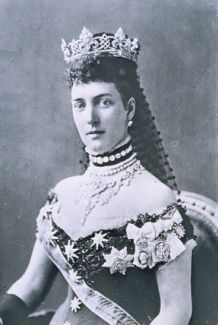 These stars were adapted to other purposes and were fitted as brooches or pins. Alexandra was exceedingly fond of her stars. . . . Yet, when she acquired the first of these ornaments, the device had been popular for almost two decades. Thanks in part to her sponsorship, however, stars were still in vogue at the beginning of the twentieth century. Snake bracelets, which Alexandra also loved, enjoyed a similarly extended fashionable life.” 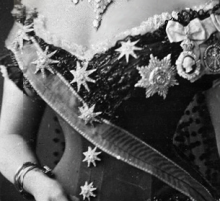 | 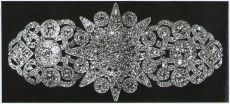 Queen Alexandra's Diamond Cockade 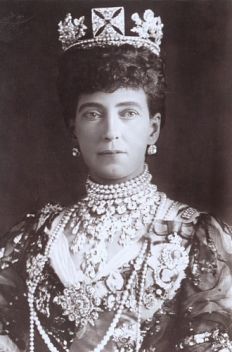 The Sunburst Diamond Brooch was put away after the Coronation of 1937 apparently. 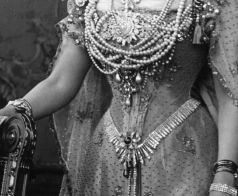 In 2008 Queen Elizabeth decided to pull it from the vaults to wear to the French State Dinner. (seen below) Supposedly the Brooch is the size of a small saucer. |
Queen Alexandra's Diamond Collier Résille 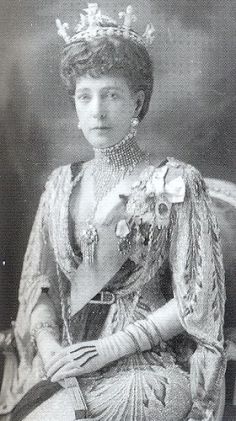 Made by Cartier in 1904. Made by Cartier in 1904.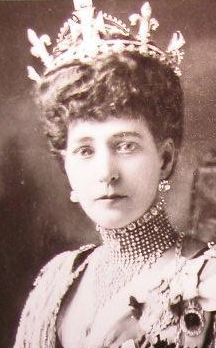 Queen Mary kept the Collier in the royal collection and wore it herself as seen here in this photograph taken below in 1947. 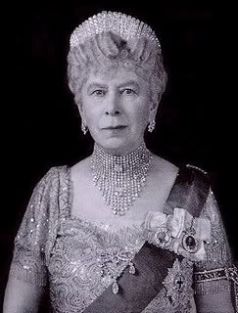 With the collier, it was possible to attach more diamonds to the end of the rows, as seen here below on Queen Mary. 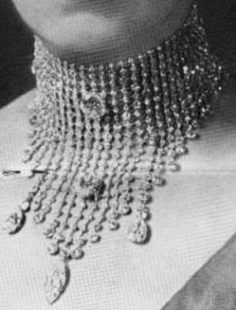 | 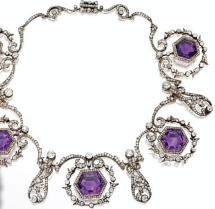 Jewels of Queen Alexandra: Amethysts Necklace/Tiara The necklace above, is designed of foliate garlands decorated with 5 hexagonal amethyts set as swing centers within circular wreaths, alternating with pear-shaped scrolls, set with 13 European-Cut diamonds weighing approx. 8.5 carats, 69 European-Cut diamonds weighing approx. 10 carats, rose-cut diamonds, weighing another 5 carats approx., numerous smaller diamonds, mounted in silver and gold. Length is 17 in. 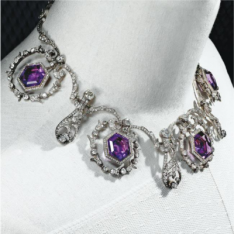 The necklace, when supported on a frame, may also be worn as a tiara. It has a wooden box of octagonal shape stamped on the lid: The Property of Her Majesty The Late Queen Alexandra.The necklace ended up with Princess Maud, Countess of Southesk nee Lady Maud Duff (grand-daughter of King Edward VII and Queen Alexandra.) The story of how Princess Maud came into possession of the necklace is not exactly known, but it is thought that the Princess died intestate which means that she had no will. According to James Pope-Hennessy, official biographer, the jewels were split up informally amongst her surviving children. Princess Maud may have received it from her mother HRH the Princess Royal as part of the Princess' inheritance upon her mother's death. Queen Alexandra. The jewel was purchased from Wartski in 1958 as part of the collection of jewels of Queen Alexandra and auctioned in the years 1988 and 2007. 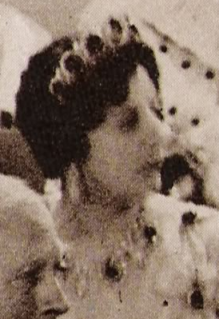 Princess Maud, Countess Southesk | Continuation of Queen Alexandra's Diamond Sunburst Brooch (Above) 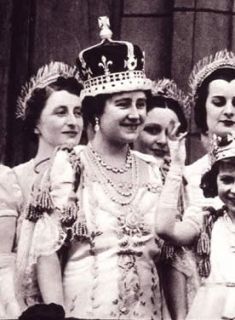 The Queen Mother, wearing the Sunburst Diamond Brooch of Queen Alexandra in the middle of her dress on her husband's coronation day. 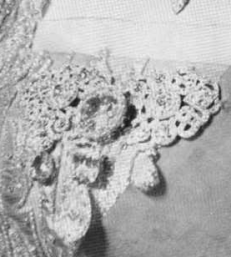 Queen Mary wearing the Decorative Side Diamond Pins that go with the original Sunburst Brooch. Instead of using the Sunburst Brooch in the middle, Mary substituted it with another diamond brooch. Hanging from the middle brooch is one of the Cullinan Diamond brooches. 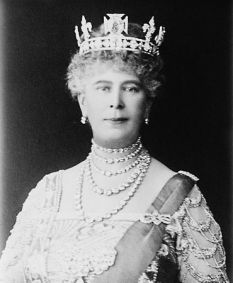 Featured in this picture, if you look closely you can see the Decorative Side Diamond Pins on Queen Mary. |
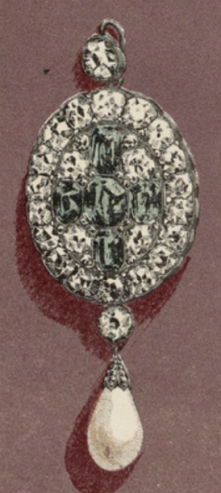 A wedding gift of a diamond and emerald cross pendant with a pearl drop from Their Royal Highnesses Prince Alfred, Princess Helena, Princess Louise, Prince Arthur, Prince Leopold, and Princess Beatrice (children of Queen Victoria and Prince Albert). [Source: <a href="https://www.rct.uk/collection/search#/39/collection/1055746/a-memorial-of-the-marriage-of-h-r-h-albert-edward-prince-of-wales-and-h-r-h" target="_self">Royal Collection</a>] | 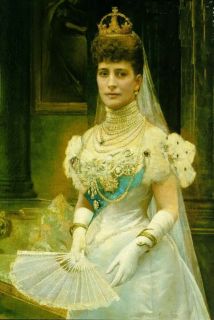 Gold Snake Bracelet Gold Snake Bracelet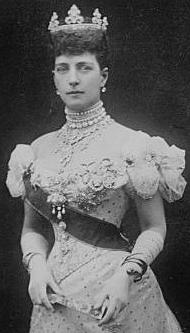 | 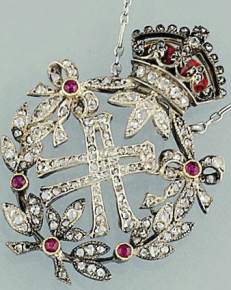 DIAMOND AND RUBY NECKLACE OF QUEEN ALEXANDRA A Royal presentation diamond and enamel pendant necklace of Queen Alexandra Of openwork design, the ruby and diamond garland with rose-cut diamond and red enamel crown surmount and central cypher of crossed initials A for Queen Alexandra wife of King Edward VII, to a trace-link neckchain, circa 1905, fitted case Sold at Christie's in London for £4,000 ($6,368 USD) 6 October 2010 London, South Kensington Lot |
Cambridge Bracelet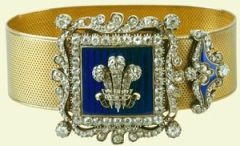 Queen Alexandra's Gold Bracelet with a Diamond and Enamel Buckle This bracelet was a wedding present to Princess Alexandra of Denmark from the Duke of Cambridge, Queen Victoria’s first cousin, and Alexandra's maternal/paternal 2nd cousin. The three diamond ostrich feathers in the centre are the heraldic badge of the Prince of Wales. The enamel clasp appears to date from early in the reign of King William IV, the Duke’s uncle. The gold bracelet with a diamond and enamel buckle c.1830 and later was made by Garrard & Co. 4.4 x 6.6 x 6.2 The turquoise and brilliant-set bracelet with the cypher “L. A.” surmounted by a crown set in diamonds on rock crystal which was made by Wondra, Darmstadt was the gift of the Prince and Princess Louis of Hesse. The gold buckle bracelet, which has a clasp of enamel and diamonds, was presented by HRH Princess Mary of Cambridge. | Queen Alexandra's Diamonds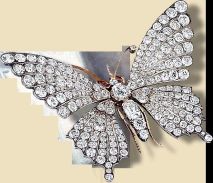 Queen Alexandra's Butterfly Brooch with Diamonds The magnificent antique diamond butterfly brooch, with en-tremblant wings and ruby eyes was last seen pictured at a family gathering to celebrate the 80th birthday of the Earl of Harewood in 2003. Lady Harewood surrounded by the Lascelles family, is sitting in the middle and clearly wearing the very large butterfly brooch. In autumn 2010, Sotheby’s Hong Kong presented the heirloom brooch for sale with an estimated selling price of US$120,000-$150,000. The auction house stated that the jewel was "in excellent condition, circa 1890, previously in the collection of Mary, Princess Royal and Countess of Harewood. (continued right) | Created by Messrs, Johnson, Walker and Tolhurst....Of great historical importance and a work of superb craftsmanship and elegance, the diamond butterfly brooch is a true treasure for period jewellery connoisseurs." Description of the brooch:Is pavé-set with 214 old mine-cut diamonds totaling 46.78 carats. The old European-cut stone which forms the body is approximately 2.60 carats. The stones are mounted in silver and have yellow gold detailing. The English-manufactured brooch has a removable fitting and is 5.20cm x 9.50cm. It dates from the late 19th century and was the present to the then Alexandra, Princess of Wales, on the occasion of her silver wedding anniversary in 1888. Later it was given to her granddaughter the Princess Royal, Countess of Harewood who wears the brooch in the picture above. It was sold by her descendants and shown to the public at the Maastricht Fair in 2010 by Humphrey Butler, London, on behalf of an English family. Mr Butler was so kind to give me the pictures and told me the brooch is simply marvellous in terms of quality. Since its appearance at the fair, it has appeared for sale at Hancocks & Co. (Jewellers) Ltd. in London. |
Wedding Presents to HRH The Princess of Wales from Her Majesty and the Prince consort: Cross Pendant, brooches, and earrings. [Source:<a href="https://www.rct.uk/collection/search#/39/collection/1055746/a-memorial-of-the-marriage-of-h-r-h-albert-edward-prince-of-wales-and-h-r-h" target="_self">Royal Collection</a>] |
| Her Majesty Queen Victoria of Great Britain |
 Queen Elizabeth I Queen Elizabeth I |
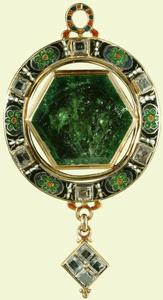 Gold, Colombian emerald, enamel, diamonds, woven material, possibly hair, behind the emerald9 x 3.7 cmFrederick, Duke of York; by whom apparently given to John Bridge (1755-1834); by descent; sale Knight Frank & Rutley, London, 3 February 1916 (lot 76); purchased by Queen Mary.Large table-cut hexagonal emerald, set and backed in gold; surrounded by a frame with white, black, blue, green and red champlevé; enamel cartouches with rosettes alternating with six table-cut diamonds. From a large red and blue enamel suspension loop and a small red enamel loop at the bottom is suspended a lozenge-shaped pendant set with four table-cut diamonds. The gold backing of the emerald is inscribed: Elizabeth R. According to the Catalogue of Additions to the King’s Audience Room, started in 1914, the pendant was ‘formerly the property of Frederick Duke of York; and by him made over to Mr. Bridge (of the Royal goldsmiths, Rundell & Bridge) and purchased from his descendants by Queen Mary in 1916. The emerald is presumed to have been among Queen Elizabeth’s jewels.’ The entry can only refer to the stone as the mount is later. Although the cut of the emerald is sixteenth century and Queen Mary acquired the pendant on the basis of the stone’s traditional association with Elizabeth I, its early history remains undocumented. The inscription on the reverse is a facsimile of Elizabeth I’s signature and was probably engraved c.1860-70, at a time when jewels and relics associated with Queen Elizabeth I and Mary, Queen of Scots, were much sought after by antiquarians. Text adapted from Ancient and Modern Gems and Jewels in the Collection of Her Majesty The Queen, London, 2008 | 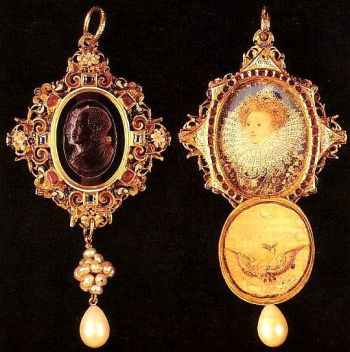 SIR FRANCIS DRAKE JEWEL The medallion dates from around 1575, but the inset miniature of Queen Elizabeth I was executed by Nicholas Hilliard about a decade later. Family tradition records that Elizabeth I gave this Sir Francis Drake jewel to him sometime between 1540-1595. Although the date on the jewel appears to be 1586, it possibly was given later in commemoration of Drake's role in the defeat of the Spanish Armada in 1588. The cameo has been skillfully cut to create two heads using contrasting colored layers of stone. The miniature is watercolor painted on vellum; enameled gold, sardonyx cameo; table-cut diamonds and rubies; pearls. Miniature painted in London by Nicholas Hilliard (born in Exeter, Devon, possibly 1547 and died in London, 1619); cameo possibly Italian; the jeweled case made in London by unidentified goldsmith. 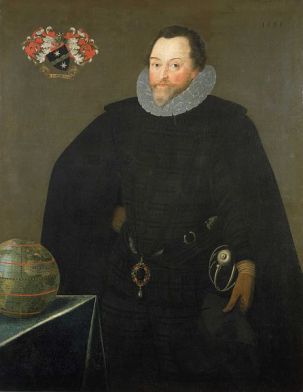 Drake is shown wearing the jewel in a portrait painted in 1591. The jewel is showcased in London's Victoria and Albert Museum. |
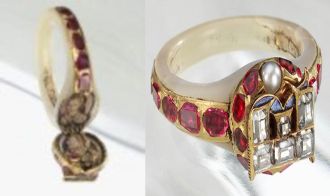 "ER RING" Elizabeth I and Anne Boleyn Ring This beautiful ring was removed from Elizabeth I’s finger after her death on March 24th 1603. The Elizabethan ring is mother-of-pearl, the band is set with rubies and the ‘E’ contains six diamonds set over a blue enamel ‘R’. A stunning pearl is also clearly visible. What makes this ring so unique is that its stunning façade hides a secret – the head of the ring is hinged and within it lie two miniature enamel portraits, one of Elizabeth c. 1575 and one of an unnamed woman. The woman wears a French hood and costume of Henry VIII’s reign. The ring itself is only 175 millimetres across and so the portraits are minute. Even so, the unnamed woman bears a strong resemblance to the sitter in the Hever and National Portrait Gallery paintings of Anne Boleyn. There is no doubt in my mind, who else would Elizabeth honour in this manner? The portrait is that of her mother Anne Boleyn, who was so callously ripped from her life when she was just two years old. 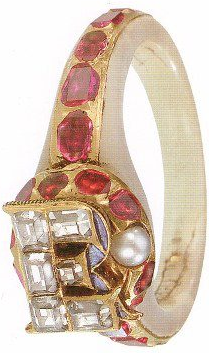 | 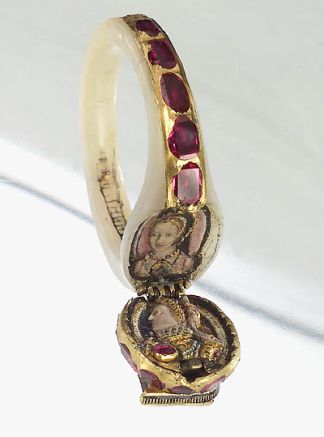 Although there are no recorded instances of Elizabeth I speaking of Anne publicly, I am sure that she often thought of her privately. I like to think that she drew strength from her mother’s courage and determination and treasured her memory. 408 years after Elizabeth’s death, mother and daughter are still together. The ring was previously in the possession of the Home family, ‘having been given from the English royal treasures by James I to the then Lord Home’ (Ives, Pg. 42). Today the ring is often referred to as the ‘Chequers ring’ as it belongs to the Trustees of Chequers, the prime minister’s country residence. In 2008 the ring was displayed publicly as part of a special display at Compton Verney. Kathleen Soriano, head of exhibitions at Compton Verney, said of the Elizabeth I pearl and ruby locket ring, “It’s a very moving piece because it’s so delicate and small and really evokes the sense of the story. It’s a very powerful object.” 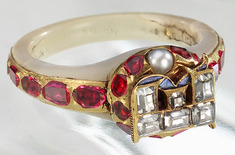 From: <a class="external" href="http://onthetudortrail.com/Blog/2011/03/24/elizabeth-i-locket-ring/" rel="nofollow" target="_blank">On the Tudor Trail</a> |
 Queen Mary I Queen Mary I |
| Princesses of the United Kingdom |
| Wallis, Duchess of Windsor |
The jewels of the Duchess were bought by her husband Edward (the former King Edward VIII) or herself.
The only pieces given to the Duchess by the Royal family were the pearls of Queen Mary as a final gesture towards her son Edward and his wife, as somewhat of an apology.
The only pieces given to the Duchess by the Royal family were the pearls of Queen Mary as a final gesture towards her son Edward and his wife, as somewhat of an apology.
| Duchesses and Ladies |
| The Westminster Jewels This splendid collection originally belonged to Princess Ekatarina Pavlovna Bagration, née Skavronskaia (1783 - 1857) 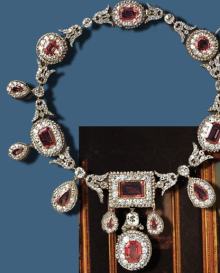 The Westminster Necklace is composed of graduated pendant clusters of oval and pear-shaped spinels within old-cut diamond surrounds. 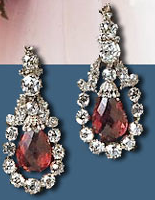 The earrings each of a facceted pendeloque spinels suspended within old-cut diamond detachable surrounds. The Duchess of Westminster has imperial Russian connections through her descent from Grand Duke Mikhail Mikhailovich and his wife Sophie von Merenberg, Countess Torby. | The Londonderry Russian Pink Topaz Pendant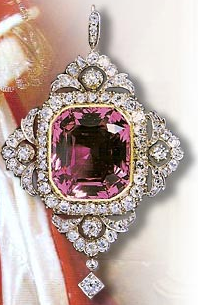 Around 1900, pink topaz made a comeback as Edwardian socialites vied to display the finest, most expensive and most unusual jewels. A few superb examples, such as the pink topaz pendant illustrated here, once owned by the Marchioness of Londonderry, demonstrate how lovely this gem can be. The revival was short-lived, and pink topaz never rose to the level of demand it had in the 1830s. This Russian Pink Topaz was given by Tsar Alexander I to Frances Anne, Marchioness of Londonderry in 1821. The stone formed part of a set of graduated pink topazes worn by Lady Londonderry on the front of her robes at the Coronation of William IV in 1830. It was later remounted with diamonds as a pendant by the Crown jewellers Garrard, possibly to mark the accession of the seventh Marquess of Londonderry on 8th February 1915. | Mountbatten Art-Deco Diamond Platinum Chain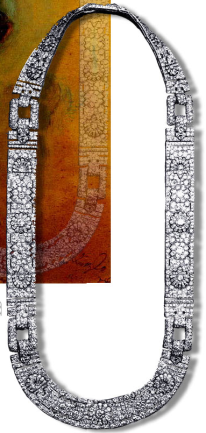 This Art Deco style diamond necklace was set in platinum. It was possible to dissemble the necklace into a short necklace and several bracelets. The future Countess wore it both ways, as short necklace or as bracelets. It was owned by Edwina Lady Mountbatten nee Ashley Her daughter Lady Pamela Hicks inherited the necklace which was sadly sold for US $71,000 in 1978.  |
The Londonderry Amethysts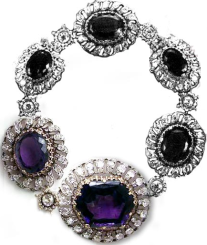 These Siberian amethysts were part of a present to Frances Anne, wife of the 3rd Marquess of Londonderry, in Vienna 1821 from Tsar Alexander I of Russia. He wanted to turn her head and gave her 14 of these highly rare and perfect Tsar-Amethysts. The best Russian amethysts come from Siberian mines, which were then owned by the Tsar. They are said to be the finest in the world because of the red and blue higlhights seen in the deep purple body colour of the stones. Lady Londonderry was charmed by the amorous attentions of the Tsar and by the precious stones he heaped upon her but she manged to end the love affair innocent of guilt.... Frances Anne had the amethysts mounted as sleeve clasps and then as a chain which she sometimes wore as a tiara, but more usually across her dress, like the ribbon of an order. 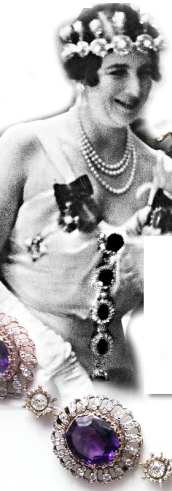 The necklace of 6 clusters centered with amethysts, pictured above, was made from the tiara in 1916 and designed by E. Wolff & Co. The wife of the 7th Marquess, Edith, above, wore them as a vertical chain reaching from her neckline to her waist. Daisy, Princess of Pless, wrote of her as one of the “universally acknowledged beauties” and always remembered Lady Londonderry’s advice at the beginning of her marriage: “My Dear, always enter a room, as if the whole place belongs to you”! The British novelist E.F. Benson also recalled the strong-minded Marchioness Edith, with something akin to admiration: “She went for life hammer and tongs…. Like a highwayman in a tiara, trampling on her enemies as if they had been a bed of nettles.” When she died, the British military journalist, Charles Repington, wrote: “She was one of the most striking and dominating feminine personalities of our time, terrifying to some, but endeared to many friends by her notable and excellent qualities”. Now on display at the <a class="external" href="http://www.vam.ac.uk/" rel="nofollow" target="_blank">Victoria and Albert Museum </a> in London, England in the Jewelry Exhibit. | The Londonderry Diamond and Pearl Tiara/Necklace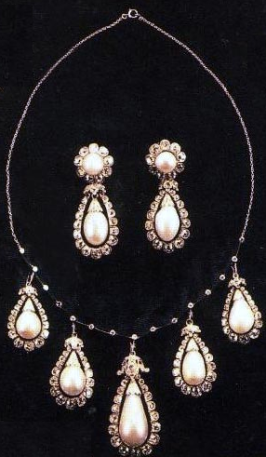 Commissioned c. 1821 by Frances Anne, wife of 3rd Marquess of Londonderry. The suite consisted of a diamond and pearl necklace, earrings and several brooches. 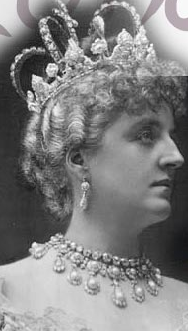 The Marchioness of Londonderry came to the Devonshire House Ball dressed as Empress Maria Theresa of Austria, a strong reference to her own powerful position in the political life of the country. The bodice was further adorned with a magnificent diamond stomacher and ropes of pearls festooned on each side. She wore a necklace of pear-shaped pearls, with another diamond rivière above and as a crown the famous Londonderry tiara which had been adapted by the addition of a cross of brilliants. The newspapers were unanimous that Lady Londonderry “looked the part to perfection” and she was listed among “the beauties of the night.” 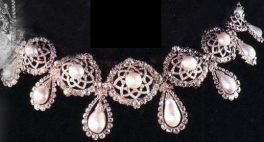 The picture above it is the tiara upside-down to demonstrate its transition into a necklace (as seen above) 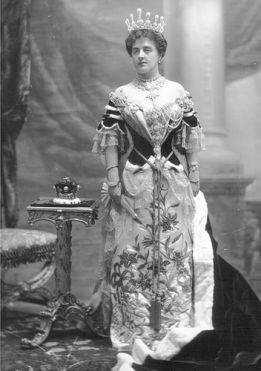 Lady Theresa, Marchioness of Londonderry, wife of the 6th Marquess wearing the necklace as a tiara. | The Londonderry Diamond Stomacher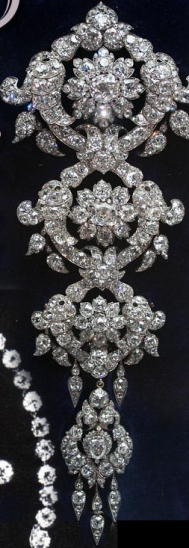 The ornament can be divided into three brooches. Garrards made it in 1853 for Frances Anne, widow of the 3rd Marquess of Londonderry The estimate for manufacture was £175. The stomacher is now on display at the <a class="external" href="http://www.vam.ac.uk/" rel="nofollow" target="_blank">Victoria and Albert Museum </a> in London, England in the Jewelry Exhibit along with the tiara and Amethysts. It is a MARVELOUS piece of jewelry, a MUST SEE! (Summer 2010) 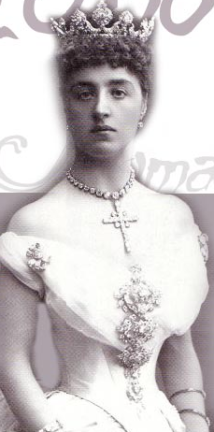 Lady Theresa, Marchioness of Londonderry, wife of the 6th Marquess. The diamond stomacher consisted of 230 carats of diamonds in total; the largest diamond was 15 carats and mounted in silver and gold. The diamonds were taken from a Garter insignia and sword of the Viscount Castlereagh which he had worn at the coronation of George IV in 1821. 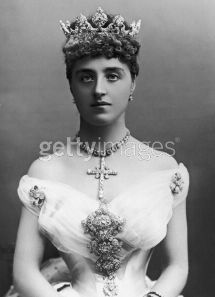 |
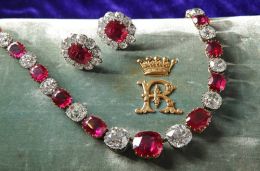 Duchess of Roxburghe Jewels This ruby and diamond jewelry belonged to Mary, Duchess of Roxburghe, and was probably purchased from Garrards (a British jewelry since 1735) by the 5th Earl of Roseberry. The jewelry rests on its original turquoise velvet case, embellished with an R monogram that sits under a coronet (R&S Garrard & Co, Goldsmith and Jewellers to The Crown). The necklace could be compared to the one Catherine Parr wears in Episode 8. 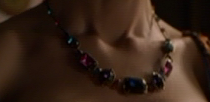 |
Sources
Some jewels already have the source in the box, for others:
Alexander Palace Time Machine Forums
<a class="external" href="http://www.christies.com/" rel="nofollow" target="_blank">Christie's of London</a> ONLINE
[[1]] by Hans Nadelhoffer
CNN
Forbes.com
Internet Stones website
Mandy's British Royalty Blog: British Jewels
The Official Royal Collection website
"The Royal Jewels" -REVISED- by Suzy Menkes
"The Queen's Jewels" by Leslie Field
The Royal Magazine website
The Royal Forums
Victoria & Albert: Art & Love, London, 2010
Wikipedia
Yahoo! News
Some jewels already have the source in the box, for others:
Alexander Palace Time Machine Forums
<a class="external" href="http://www.christies.com/" rel="nofollow" target="_blank">Christie's of London</a> ONLINE
[[1]] by Hans Nadelhoffer
CNN
Forbes.com
Internet Stones website
Mandy's British Royalty Blog: British Jewels
The Official Royal Collection website
"The Royal Jewels" -REVISED- by Suzy Menkes
"The Queen's Jewels" by Leslie Field
The Royal Magazine website
The Royal Forums
Victoria & Albert: Art & Love, London, 2010
Wikipedia
Yahoo! News
